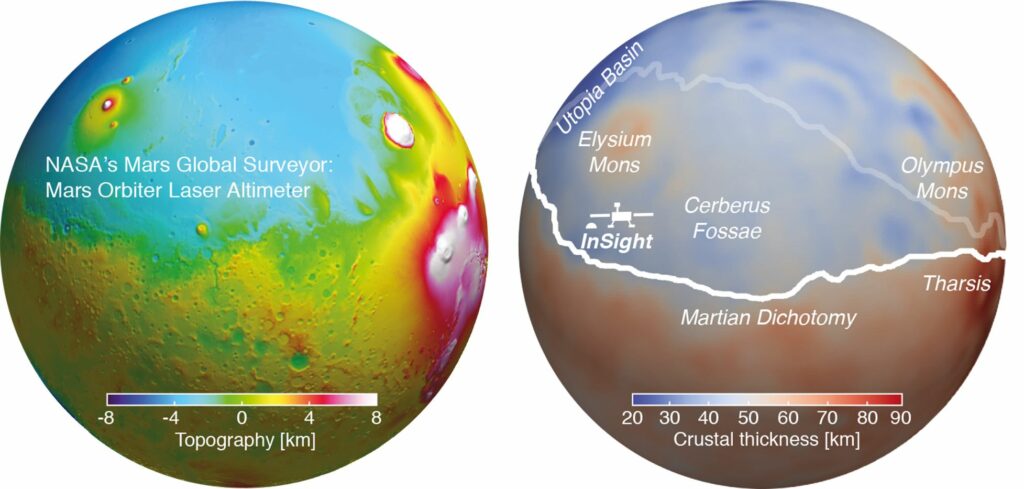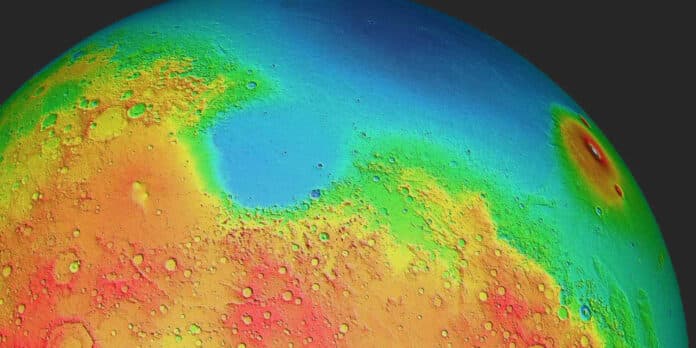In May 2022, the NASA InSight lander recorded a ‘monster’ of a marsquake with a magnitude-4.6. The event sent strong seismic waves traveling across the Martian surface.
By continually monitoring and with the power levels decreasing on InSight’s seismometer, scientists at ETH Zurich gathered the data from a sizeable marsquake. They found that the seismic waves traveled from the quake’s source to the measuring station and continued to travel around the entire planet several times.
Along with offering specific information about Mars, the study also provides a global view of the planet. Researchers determined the global average thickness of the Martian crust based on the surface waves.
Doyeon Kim, a seismologist at the Institute of Geophysics at ETH Zurich, said, “From this quake, the largest quake recorded during the entire InSight mission, we observed surface waves that circled Mars up to three times. The researchers measured how fast these waves propagate at different frequencies to gain information about the structure that the waves passed through.”
Scientists determined the thickness of the Martian crust by combining their newly obtained results with existing data on the gravity and topography of Mars. It averages 42 to 56 kilometers (26 – 35 miles). The crust is thinnest at the Isidis impact basin at ~10 km (6 miles) and thickest at Tharsis province at ~90 km (56 miles).
Kim said, “This means that the Martian crust is much thicker than that of the Earth or the Moon. Generally, smaller planetary bodies in our solar system have a thicker crust than larger bodies. We were fortunate to observe this quake. On Earth, we would have difficulty determining the thickness of the Earth’s crust using the same magnitude of quake that occurred on Mars. While Mars is smaller than the Earth, it transports seismic energy more efficiently.”
The study highlights the difference between the northern and southern hemispheres of Mars. On Mars, the northern hemisphere comprises low, level terrain, whereas the southern hemisphere comprises high plateaus. A Martian dichotomy is the separation between the northern and southern highlands.

Kim said, “One might think this difference could be explained by two different rock compositions. One rock would be denser than the other. While the composition may be the same in the north and south, the thickness of the crust varies. If the crust is thicker in the south, there would be less dense Martian mantle material underneath it, whereas a thinner crust in the north would have more of this dense, heavier material.”
Scientists noted, “Based on the seismic observations and the gravity data, we show that the density of the crust in the northern lowlands and the southern highlands is similar.”
“In contrast, the crust in the southern hemisphere extends to a greater depth than in the northern hemisphere.”
“This finding is fascinating and allows an end to a long-standing scientific discussion on the origin and structure of the Martian crust. After all, analysis of meteorite impacts on Mars last year already provided evidence that the crusts in the north and south are made of the same material.”
Kim said, “Our study provides how the planet generates heat and explains Mars’ thermal history. As a single-plate planet, the main source of heat produced in the interior of Mars today is a result of the decay of radioactive elements such as thorium, uranium, and potassium. The study found 50 to 70 percent of these heat-producing elements in the Martian crust. This high accumulation could explain why there are local regions underneath where melting processes may still occur today.”
Journal Reference:
- Doyeon Kim, Cecilia Duran, et al. Global crustal thickness revealed by surface waves orbiting Mars. ESS Open Archive. March 06, 2023. DOI: 10.22541/essoar.167810298.85030230/v1
